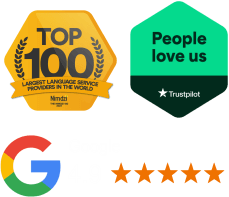Plain language
YOUR ACTIONS DO NOT BRING THE DESIRED RESULTS? PLAIN LANGUAGE MAY BE THE SOLUTION.


WHY CHOOSE OUR TRANSLATION SERVICES?
PLAIN LANGUAGE – WHAT CONCEPT IS THIS?
Plain language – the language of clear thoughts – is a way of writing business and official texts that makes them understandable to a mass audience on first reading. It is a language for quick reading, allowing us to read at our natural pace texts that would normally require more time and energy to understand.
When writing functional texts, we sometimes unconsciously complicate the message. This may, for example, result in potential clients being put off using our services by a convoluted description on our website. All this makes plain language worth using – it will certainly make our content easier to understand.
WHERE CAN PLAIN LANGUAGE BE USED?
Plain language works well in company documents, internal and external communication (including online conversations and e-mails), marketing materials, and website content – almost anywhere (though it will obviously not be used in literary texts or scientific papers). Offices are also encouraged to use plain language, and it is worth using in legal and medical documents too.



THE PRINCIPLES OF PLAIN LANGUAGE
Here are the basic principles of plain language (source: gov.pl):
- Use correct language.
- Write the text with a reader who does not have much knowledge of the subject in mind – the best way is to imagine that you are addressing the text to a child or an elderly person.
- Often use personal pronouns and address the reader directly.
- Write in your own words.
- Refer to your institution as “we”.
- Put the most important information at the beginning of the text.
- Make sure your statement is arranged in a logical order.
- Use short sentences.
- Avoid the passive voice.
- Do not use specialised vocabulary, and remember to explain any terms the reader may not understand.
- Use common and understandable words – the shorter and simpler, the better.
- Use lists and tables, and highlight the most important parts of the text in bold.
- Include informative headlines – they help the reader find the information they are looking for.
- Avoid digressions and beating around the bush; stay on topic.
- Avoid writing about writing, e.g. using the phrases “Please be informed” or “Please be notified”.
- Use natural sentence order – first the subject (noun), then the predicate (verb).
- Use more verbs than nouns in your text.
- Avoid pompous, elevated style.
- Avoid gerunds, i.e. forms ending in -ing (advocates of plain Polish call them zombie nouns); try not to use phrases that require the use of such nouns, e.g. “in case of”, “for the purpose of”, “as a result of”.
- Do not use impersonal verb forms such as “it was done” or “it was closed”.
- Avoid using participles where not necessary.
- Avoid abstract nouns.
- Provide the legal basis at the end of the text.
EXAMPLES OF PLAIN LANGUAGE WRITING
EXAMPLE 1
In normal language:
The CLIENT is obliged to provide the CONTRACTOR with materials for translation, Terminology (if applicable), unless the CLIENT has ordered Terminology preparation Services, and supporting materials (if any). The CLIENT shall designate competent persons on behalf of the CLIENT to cooperate with the CONTRACTOR in the performance of the Terminology preparation Services and approve the Terminology; however, in the case of the CLIENT being a Consumer, only if the specificity of the Order so requires.
In plain language:
The CLIENT is to provide the CONTRACTOR with:
- materials for translation
- terminology – if it is to be used and the CLIENT has not requested its preparation
- supporting materials (if any)
If the specific nature of the order so requires, the CLIENT should designate persons knowledgeable about the subject to assist the CONTRACTOR in preparing the terminology.
EXAMPLE 2
In normal language:
The order shall be considered completed by the CONTRACTOR if they deliver the translation to the CLIENT in the manner referred to in paragraph 4 below so that the CLIENT has the opportunity to acquaint themselves with its content, and in the case of interpreting – upon completion of the interpreting service.
In plain language:
In the case of written translations, the CONTRACTOR completes the work when they deliver the translation to the CLIENT so that they can check it. Interpretation is completed when the CONTRACTOR has finished interpreting.
Summary Translation Service
In today’s interconnected world, your content needs to resonate across cultures and languages. Our Summary Translation Service is specifically designed to bridge the language gap to connect you with your global audience. What we offer distils the essence of your content into concise, culturally adapted summaries that appear in multiple languages. Whether you are a multinational corporation, a bustling news portal, or an educational platform, we ensure that your core message is not just translated, but transformed. We understand the nuances of language and cultural contexts, so that your message retains its original tone, style, and intent, while appealing to diverse global users. This is not just about making your content accessible, it is also about making it engaging, relevant, and resonant for every reader, regardless of their language. With our Summary Translation Service, you can expand your reach, enhance user engagement, and ensure that your message is both seen and understood worldwide.
